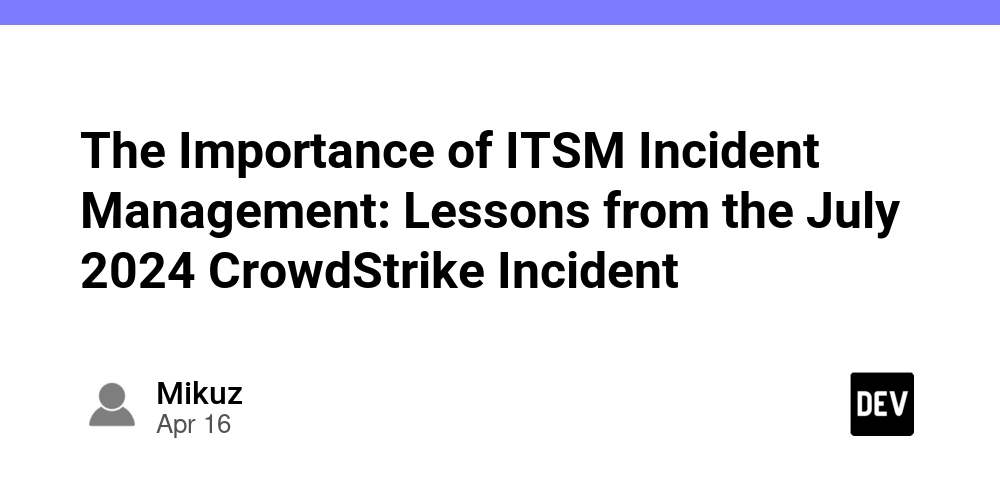The Importance of ITSM Incident Management: Lessons from the July 2024 CrowdStrike Incident
A catastrophic Windows system failure on July 19, 2024, demonstrated why ITSM incident management is crucial for modern organizations. When a faulty CrowdStrike update triggered blue screen errors on over 8 million devices globally, it disrupted essential services across healthcare, aviation, banking, and media sectors. This event underscores the critical importance of having robust incident management processes in place. Such processes, as defined by ITIL 4 service management guidelines, focus on quickly restoring services and minimizing disruption when technical issues arise. Effective incident management not only maintains customer satisfaction but also preserves an organization's reputation and ensures continuous value delivery in service relationships. Incident Registration: The Critical First Step Service disruptions can severely impact business operations, leading to decreased productivity, damaged reputation, and financial losses. Swift incident detection plays a vital role in minimizing these negative effects. Organizations employ two primary methods for identifying service incidents: Automated Detection Systems Modern IT departments deploy sophisticated monitoring tools that continuously watch for service anomalies. These systems use predefined parameters to automatically flag potential incidents, enabling rapid response before users notice problems. This proactive approach demonstrates service excellence, as IT teams can address issues before they impact end users. User-Based Reporting Despite automated systems, user reports remain a significant source of incident detection. Users can report issues through multiple channels, including: Phone support lines Email helpdesks Self-service portals Ticketing systems Creating the Incident Record Once detected, each incident requires proper documentation in a centralized system. This documentation serves as an essential reference point throughout the resolution process and for future analysis. The incident record must include: Unique identifier code Timestamp of occurrence Reporter's information Detailed incident description Impact assessment Supporting documentation (screenshots, error logs) Advanced Detection Methods Organizations increasingly employ innovative approaches to incident detection, including: Social media monitoring for service complaints Analysis of unusual usage patterns AI-driven anomaly detection Customer feedback analysis The quality and completeness of incident registration directly influence resolution speed and effectiveness. Whether handled manually by service desk personnel or automatically through monitoring systems, proper incident registration forms the foundation for successful incident management. Incident Categorization: Establishing Response Priority After registering an incident, support teams must systematically evaluate and classify the issue to determine appropriate response measures. This crucial step ensures resources are allocated efficiently and critical issues receive immediate attention. Impact Assessment Support teams evaluate the incident's scope and severity by considering: Number of affected users or systems Business functions disrupted Financial implications Potential regulatory compliance issues Urgency Determination Urgency levels are assigned based on several factors: Time sensitivity of affected services Business cycle considerations SLA requirements Potential for escalating problems Priority Matrix Implementation Organizations typically use a priority matrix that combines impact and urgency scores to determine overall incident priority. A standard classification might include: Priority Level Response Time Example Scenario Critical (P1) Immediate Complete system outage affecting core business High (P2) Within 1 hour Major function disruption for multiple users Medium (P3) Within 4 hours Limited impact on non-critical services Low (P4) Within 24 hours Minor inconvenience, workaround available Team Assignment Proper categorization facilitates: Efficient routing to appropriate technical teams Identification of similar past incidents Activation of specialized response teams Implementation of predefined resolution procedures The categorization process remains dynamic, allowing for adjustments as new information becomes available. This flexibility ensures the response remains aligned with business impact and technical requirements throughout the lifecycle. Incident Response: Effective Communication Strategy Clear, consistent communication forms the backbone of successful incident management. Organizations must establish robust notification protocols to keep stakeholders informed and maintain confidence during disruptions. Essential Communication Elements Every incident notification should address:

A catastrophic Windows system failure on July 19, 2024, demonstrated why ITSM incident management is crucial for modern organizations. When a faulty CrowdStrike update triggered blue screen errors on over 8 million devices globally, it disrupted essential services across healthcare, aviation, banking, and media sectors.
This event underscores the critical importance of having robust incident management processes in place. Such processes, as defined by ITIL 4 service management guidelines, focus on quickly restoring services and minimizing disruption when technical issues arise. Effective incident management not only maintains customer satisfaction but also preserves an organization's reputation and ensures continuous value delivery in service relationships.
Incident Registration: The Critical First Step
Service disruptions can severely impact business operations, leading to decreased productivity, damaged reputation, and financial losses. Swift incident detection plays a vital role in minimizing these negative effects. Organizations employ two primary methods for identifying service incidents:
Automated Detection Systems
Modern IT departments deploy sophisticated monitoring tools that continuously watch for service anomalies. These systems use predefined parameters to automatically flag potential incidents, enabling rapid response before users notice problems. This proactive approach demonstrates service excellence, as IT teams can address issues before they impact end users.
User-Based Reporting
Despite automated systems, user reports remain a significant source of incident detection. Users can report issues through multiple channels, including:
- Phone support lines
- Email helpdesks
- Self-service portals
- Ticketing systems
Creating the Incident Record
Once detected, each incident requires proper documentation in a centralized system. This documentation serves as an essential reference point throughout the resolution process and for future analysis. The incident record must include:
- Unique identifier code
- Timestamp of occurrence
- Reporter's information
- Detailed incident description
- Impact assessment
- Supporting documentation (screenshots, error logs)
Advanced Detection Methods
Organizations increasingly employ innovative approaches to incident detection, including:
- Social media monitoring for service complaints
- Analysis of unusual usage patterns
- AI-driven anomaly detection
- Customer feedback analysis
The quality and completeness of incident registration directly influence resolution speed and effectiveness. Whether handled manually by service desk personnel or automatically through monitoring systems, proper incident registration forms the foundation for successful incident management.
Incident Categorization: Establishing Response Priority
After registering an incident, support teams must systematically evaluate and classify the issue to determine appropriate response measures. This crucial step ensures resources are allocated efficiently and critical issues receive immediate attention.
Impact Assessment
Support teams evaluate the incident's scope and severity by considering:
- Number of affected users or systems
- Business functions disrupted
- Financial implications
- Potential regulatory compliance issues
Urgency Determination
Urgency levels are assigned based on several factors:
- Time sensitivity of affected services
- Business cycle considerations
- SLA requirements
- Potential for escalating problems
Priority Matrix Implementation
Organizations typically use a priority matrix that combines impact and urgency scores to determine overall incident priority. A standard classification might include:
| Priority Level | Response Time | Example Scenario |
|---|---|---|
| Critical (P1) | Immediate | Complete system outage affecting core business |
| High (P2) | Within 1 hour | Major function disruption for multiple users |
| Medium (P3) | Within 4 hours | Limited impact on non-critical services |
| Low (P4) | Within 24 hours | Minor inconvenience, workaround available |
Team Assignment
Proper categorization facilitates:
- Efficient routing to appropriate technical teams
- Identification of similar past incidents
- Activation of specialized response teams
- Implementation of predefined resolution procedures
The categorization process remains dynamic, allowing for adjustments as new information becomes available. This flexibility ensures the response remains aligned with business impact and technical requirements throughout the lifecycle.
Incident Response: Effective Communication Strategy
Clear, consistent communication forms the backbone of successful incident management. Organizations must establish robust notification protocols to keep stakeholders informed and maintain confidence during disruptions.
Essential Communication Elements
Every incident notification should address:
- Current incident status and severity
- Expected resolution timeframe
- Business impact assessment
- Available workarounds
- Next update schedule
Stakeholder Management
Different stakeholders require varying levels of detail and communication frequency:
| Stakeholder Type | Communication Need | Update Frequency |
|---|---|---|
| End Users | Basic status updates | As status changes |
| Technical Teams | Detailed technical info | Real-time |
| Management | Business impact focus | Regular intervals |
| External Clients | Service availability | Major milestones |
Communication Channels
Organizations should use multiple communication channels:
- Status page updates
- Email notifications
- SMS alerts
- Internal messaging platforms
- Social media updates
- Service desk portal announcements
Automated Notification Systems
Modern incident response relies on automated communication tools that provide:
- Instant alert distribution
- Consistent message formatting
- Status change tracking
- Communication audit trails
- Stakeholder confirmation tracking
Effective communication builds trust with users and maintains organizational reputation. By implementing clear protocols and leveraging automation, support teams can focus on resolution while keeping stakeholders informed.
Conclusion
The July 2024 CrowdStrike incident demonstrates how technical failures can cascade into widespread business disruptions. Organizations must implement robust incident management processes to protect against similar scenarios.
Effective incident management requires attention to three core components:
- Thorough incident registration
- Precise categorization
- Clear stakeholder communication
Organizations should regularly evaluate and update their incident management procedures to:
- Strengthen detection mechanisms
- Refine categorization criteria
- Improve communication protocols
- Enhance automated response capabilities
- Update stakeholder management processes
By maintaining focus on these essential elements, organizations can build resilient incident management processes that minimize service disruptions and maintain business continuity. The investment ultimately protects both operational efficiency and organizational reputation.









































































































































































![[The AI Show Episode 144]: ChatGPT’s New Memory, Shopify CEO’s Leaked “AI First” Memo, Google Cloud Next Releases, o3 and o4-mini Coming Soon & Llama 4’s Rocky Launch](https://www.marketingaiinstitute.com/hubfs/ep%20144%20cover.png)




























































































































![[DEALS] The All-in-One Microsoft Office Pro 2019 for Windows: Lifetime License + Windows 11 Pro Bundle (89% off) & Other Deals Up To 98% Off](https://www.javacodegeeks.com/wp-content/uploads/2012/12/jcg-logo.jpg)




























![Is this too much for a modular monolith system? [closed]](https://i.sstatic.net/pYL1nsfg.png)






















































































































_Andreas_Prott_Alamy.jpg?width=1280&auto=webp&quality=80&disable=upscale#)






























































































![What features do you get with Gemini Advanced? [April 2025]](https://i0.wp.com/9to5google.com/wp-content/uploads/sites/4/2024/02/gemini-advanced-cover.jpg?resize=1200%2C628&quality=82&strip=all&ssl=1)












![Apple Shares Official Trailer for 'Long Way Home' Starring Ewan McGregor and Charley Boorman [Video]](https://www.iclarified.com/images/news/97069/97069/97069-640.jpg)
![Apple Watch Series 10 Back On Sale for $299! [Lowest Price Ever]](https://www.iclarified.com/images/news/96657/96657/96657-640.jpg)
![EU Postpones Apple App Store Fines Amid Tariff Negotiations [Report]](https://www.iclarified.com/images/news/97068/97068/97068-640.jpg)
![Apple Slips to Fifth in China's Smartphone Market with 9% Decline [Report]](https://www.iclarified.com/images/news/97065/97065/97065-640.jpg)



































































































































